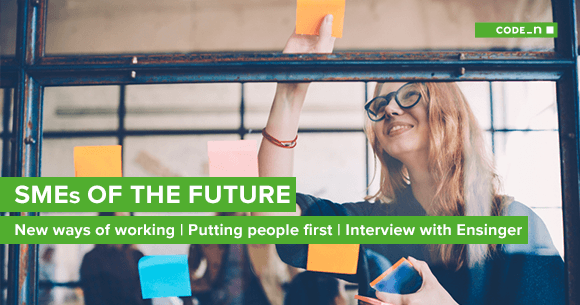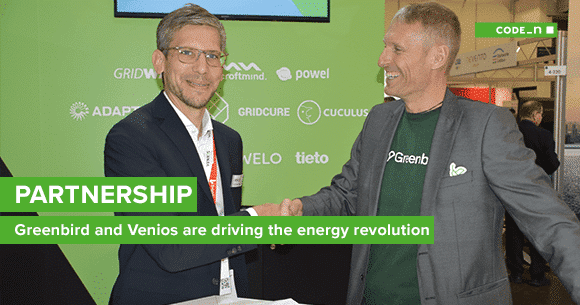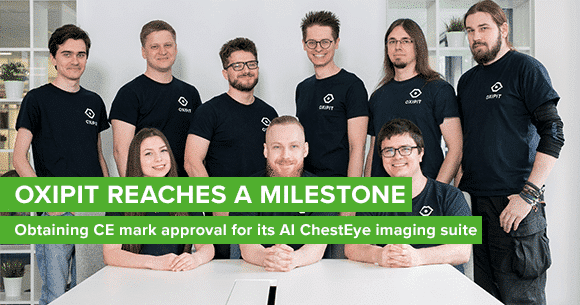Anja Gnest: "There’s one criterion for success that applies universally: authenticity. That must come through, explicitly and implicitly."Anja Gnest: „Ein Erfolgskriterium ist meines Erachtens für alle gleich: Authentizität. Das muss durchschlagen, nach außen und nach innen."
Janina Benz: Hi Anja, could you briefly introduce yourself to our readers?
Anja Gnest: Of course! In 2004, I started working in re-launch support for the Internet department at Deutsche Messe. Initially, this was on a short-term project contract, but I quickly became passionate about the interim work that I was doing. At the time, I was preparing for the examination to become a licensed accountant. Although I passed the exam, I never started a career in accounting. I learned a great deal through my work on the CeBIT website. Unlike other exhibitions, CeBIT target groups have a much higher affinity for all things online, so I was constantly confronted with the latest topics related to the Web. For example, in 2007, I worked on the first search engine campaign; in 2010, the first Facebook page. I am currently heavily involved with SEO, and, for the past year, I have been supporting the mobile phone team with the development and marketing of apps. At the moment, I am actively engaged in extending our social media activities and am contributing to a very exciting project on “Enterprise 2.0.”
JB: CODE_n was one of the most discussed topics on Twitter during CeBIT, under the hashtag #CODE_n. What were the preparations like on your end? How big is your social media team? How much traffic do your website, blog, etc. receive?
AG: Our social media team currently only consists of two people – my colleague Matthias Venzke and me. We’ve been responsible for social media communication for 12 different events now. Agencies support us with editorial work and campaign planning. Other highly motivated colleagues from our sales and PR teams are also active on our behalf in the social Web. CeBIT is our most talked about exhibition, followed by the trade show HANNOVER MESSE.
This year, our followers on Facebook and Twitter have doubled in numbers compared to 2011. During the exhibition, we were answering questions on a minute-by-minute basis; questions regarding our apps, how to get to the trade show grounds, about hotel accommodations, etc. 2012 was an incredibly exciting event year. The upward trend in use of the social Web is distinct. As a result, we have decided to vigorously continue working on our strategy for 2013. We plan to establish ourselves even more within social networks and offer our customers the very best in services and exclusive information.
The CeBIT website welcomes approximately 4 million visitors from around the world. Our guests primarily look for exhibitors, plan their trade show visit, or register for and purchase tickets. This year, people from 130 countries talked about our exhibition via the social Web. Other impressive participation numbers can be attributed to our Social Media Command Center, powered by salesforce.com. Check out the German CeBIT blog for a graph highlighting other Web activity results.
The CeBIT blog moved in a new direction this year. Through our “blog scholarship,” we were able to welcome 4 wonderfully diverse bloggers to the team. Even professional bloggers like Sascha Lobo continue to support us with fascinating posts, and exhibition staff has contributed background information relating to interesting projects. However, the blog is currently only available in German.
JB: What are the plans for Hanover after CeBIT? How will CeBIT’s social media activities move forward?
AG: Our strategy for 2013 presents us with two great challenges. On one hand, we plan to support the sales department in acquiring young and innovative businesses – enterprises that CeBIT can offer particularly unique opportunities. On the other hand, we would like to offer our followers and fans more exclusive content. Working with them, we hope to extend our services so that they are fully prepared and have all the information they need to make the next exhibition a success.
JB: With respect to CODE_n, we had the most success with Twitter. What would you say are the benefits of Facebook and Twitter, and how do they differ?
AG: Like CODE_n, most CeBIT-related discussions were tweeted. In terms of quantity, this isn’t all that surprising. The limited number of characters, inherent speed, and up-to-the-minute nature of Twitter means post and comments will naturally be more frequent and numerous.
I think the main difference is the context. Whereas I mainly use Twitter to inform my followers about news, interesting facts and other unique information, I use Facebook primarily to communicate with friends, people with the same interests, business partners and my family. The benefits of Twitter are clear: There are advantages to quickly sharing knowledge and opinions. I find that Facebook, and now Google+, are excellent discussion and service platforms. What I really like about Facebook is that our fans help each other and answers each others’ questions, more than our Twitter followers do.
JB: Many of our CODE_n finalists primarily used social media to market themselves. The time and effort invested into these activities is often underestimated. Would you say there is a golden rule for success in the social Web?
AG: Yes and no. There isn’t a golden rule that can be applied to every company. Businesses need to strategically develop their own success criteria.
But as far as I’m concerned, there’s one criterion for success that applies universally: authenticity. That must come through, explicitly and implicitly. This is easier for young companies like your finalists than large businesses with a long history. But every company can and should face the changes in communication techniques, to be successful in the social Web and beyond.
JB: The advertising tools in Facebook and Twitter are becoming more and more popular, and social media marketing spends are growing rapidly. How would you most efficiently work with a restricted startup budget?
AG: We don’t have any experience with Twitter ads yet. Our budget primarily goes to editorial services, monitoring, and promotions.
We draw attention to our promotions with Facebook ads. Facebook offers unparalleled targeting opportunities, and I know to appreciate their value. Coupled with targeted user interests, regional and demographic control reduces redundant spend. The actual CPC of our advertisements is generally below the price suggested by Facebook, and the budget can generally be based on a daily or contract period. If money is an issue for a recent startup, Facebook presents wonderful options in terms of marketing investment.
Some tips based on our experience: appealing visuals, animated text, various ads in rotation – these all give good indications of how to best reach desired target groups. Linking to internal Facebook content (fan page, event, app) can be a recipe for success, since Facebook users tend to want to stay on the Facebook site.
Janina Benz: Hallo Anja, kannst du dich unseren Lesern kurz vorstellen?
Anja Gnest: Klar! 2004 habe ich als Relaunch-Unterstützung befristet in der Internet-Abteilung der Deutschen Messe angefangen. Was als Übergangslösung gedacht war, entpuppte sich als Leidenschaft. Ich steckte gerade in der Vorbereitung auf die Abschlussprüfung zur Bilanzbuchhalterin. Diese habe ich zwar erfolgreich abgeschlossen, aber den Beruf ganz schnell an den Nagel gehängt. Mit der Verantwortung für die CeBIT-Website habe ich wahnsinnig viel gelernt. Weil die CeBIT-Zielgruppe online affiner ist, als die anderer Messen, wurde ich laufend mit den neuesten Themen konfrontiert. Beispielsweise habe ich 2007 die erste Suchmaschinen-Kampagne durchgeführt, 2010 die erste Facebook-Seite angelegt, treibe das Thema SEO voran und unterstütze seit einem Jahr noch das mobile Team in der App-Entwicklung und –Vermarktung. Aktuell widme ich mich ganz intensiv dem Ausbau unserer Social Media Aktivitäten und bin an einem sehr spannenden Projekt zum Thema „Enterprise 2.0“ beteiligt.
JB: Mit unserem Hashtag #CODE_n waren wir eines der meist diskutierten Themen während der Messe. Wie muss ich mir eure Vorbereitungen vorstellen: wie groß ist euer Social Media Team? Von welchen Traffic-Dimensionen sprechen wir hier für Webseite, Blog, etc.?
AG: Unser Social Media Team besteht derzeit aus (nur) zwei Personen. Mein Kollege Matthias Venzke und ich sind für die Social Media Kommunikation von nun schon 12 Veranstaltungen verantwortlich. Bei der Redaktion und Kampagnenplanung werden wir von Agenturen unterstützt. Auch einige Kollegen aus den Vertriebs- und PR-Teams sind sehr motiviert und im Namen unserer Marken im Social Web unterwegs. Die CeBIT ist unsere am meisten diskutierte Messe, gefolgt von der HANNOVER MESSE.
In diesem Jahr folgen uns doppelt so viele Personen bei Facebook und Twitter wie noch in 2011. Wir haben während der Messe quasi im Minutentakt diverse Fragen beantwortet. Zu unseren Apps, zur Anreise und Übernachtungsmöglichkeiten, etc. 2012 war ein unheimlich aufregendes Veranstaltungsjahr. Es zeichnet sich ab, dass sich der Aufwärtstrend im Social Web fortsetzt. Aus dem Grund werden wir mächtig an der Strategie 2013 ff. arbeiten und uns noch besser aufstellen, damit wir unseren Kunden in den sozialen Netzwerken weiterhin den bestmöglichen Service und exklusive Informationen bieten können.
Die CeBIT-Website begrüßt jährlich rund 4 Mio Besucher aus aller Welt, die vorrangig nach Ausstellern suchen, ihren Messebesuch planen oder Tickets registrieren und kaufen. Im Social Web sprachen dieses Jahr Menschen aus 130 Ländern über unsere Messe. Weitere spannende Zahlen sind Ergebnisse unseres Social Media Command Centers powered by salesforce.com. Eine Infografik über die Ergebnisse gibt’s im CeBIT-Blog.
Das CeBIT-Blog hat sich in diesem Jahr neu ausgerichtet. Wir haben über unser Blogstipendium 4 tolle und ganz unterschiedliche Blogger für uns gewinnen können. Auch Profiblogger wie Sascha Lobo unterstützen uns weiterhin mit spannenden Beiträgen. Zudem werden Mitarbeiter der Messe Hintergrund-Beiträge aus interessanten Projekten verfassen.
JB: Wie geht es nun nach der CeBIT mit den Social Media Aktivitäten in Hannover weiter?
AG: Für unsere Strategie 2013 stehen wir vor zwei großen Herausforderungen. Zum Einen wollen wir den Vertrieb bei der Akquirierung junger innovativer Unternehmen unterstützen, denen die CeBIT besondere und einmalige Chancen bietet. Zum Anderen möchten wir unseren Followern und Fans mehr exklusive Inhalte bieten und mit ihnen gemeinsam unsere Services ausbauen, damit sie bestens vorbereitet und informiert eine tolle Zeit auf der Messe verbringen können.
JB: Im Rahmen von CODE_n hatten wir die besten Erfolge mit Twitter. Wo siehst du die unterschiedlichen Vorteile von Facebook und Twitter?
AG: Auch zur CeBIT wurden die meisten Konversationen bei Twitter geführt. Rein quantitativ betrachtet ist das kein Wunder. Durch die Zeichenbegrenzung, erforderliche Schnelligkeit und nötige Aktualität ist die Frequenz der abgesetzten Meldungen um ein Vielfaches höher.
Den wesentlichen Unterschied macht meines Erachtens der Nutzungskontext aus. Während ich mich und meine Follower vorrangig bei Twitter über News, Fakten und sonstige interessante Dinge informiere, tausche ich mich bei Facebook eher mit Freunden, Gleichgesinnten, Partnern und der Familie aus. Die Vorteile von Twitter sind für mich ganz klar, der Wissensvorsprung und schnelle Meinungsaustausch. Facebook, mittlerweile auch Google+, sind für mich eine tolle Diskussions- und Serviceplattform. Was ich an Facebook besonders toll finde ist, dass sich unsere Fans gegenseitig helfen und Fragen beantworten, mehr noch als das Follower bei Twitter tun.
JB: Viele unserer CODE_n Finalisten vermarkten sich hauptsächlich über die sozialen Medien. Doch der Aufwand wird gerne unterschätzt. Gibt es deiner Meinung nach eine goldene Regel um im Social Web erfolgreich zu sein?
AG: Jein. Die eine goldene Regel, die sich auf jedes Unternehmen anwenden lässt, gibt es nicht. Unternehmen müssen ihre eigenen Erfolgskriterien strategisch entwickeln.
Doch ein Erfolgskriterium ist meines Erachtens für alle gleich: Authentizität. Das muss durchschlagen, nach außen und nach innen. Jungen Unternehmen wie Euren Finalisten fällt das meist leichter als Unternehmen, deren Historie weit zurück reicht. Aber jedes Unternehmen kann und sollte sich dem Wandel des Kommunikationsverhaltens stellen, um (nicht nur) im Social Web erfolgreich zu sein.
JB: Die Advertising-Tools in Facebook und Twitter werden immer stärker nachgefragt. Social Media Marketing Spendings steigen rapide an. Wie würdest du ein knappes Startup-Budget am effizientesten einsetzen?
AG: Mit Twitter-Ads haben wir bisher keine Erfahrungen gemacht. Unser Budget fließt vor allem in die redaktionelle Betreuung, das Monitoring und Aktionen.
Die Aktionen bewerben wir durch Facebook-Ads. Zu schätzen weiß ich daran, dass Facebook unvergleichbar gute Targeting-Möglichkeiten bietet. Regionale, demografische und Einschränkungen auf Nutzer-Interessen minimieren den Streuverlust. Der tatsächliche CPC unserer Anzeigen liegt meist unter dem vorgeschlagenen Preis von Facebook. Und das Budget lässt sich in Tages- oder Laufzeitbudgets planen. Für ein knappes Startup-Budget sind das doch perfekte Vorraussetzungen.
Tipps auf Basis unserer Erfahrungen: Ansprechende Bilder, animierende Texte, mehrere Anzeigen in Rotation zu- und abschalten bringt tolle Erkenntnisse darüber wie man am besten die gewünschte Zielgruppe erreicht, Verlinkung auf Facebook internen Content (Fanpage, Veranstaltung, App), Facebook-Nutzer möchten lieber auf Facebook bleiben.
JB: Vielen Dank für das nette Interview! 🙂






Write a comment